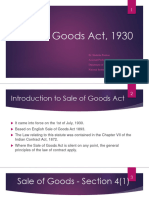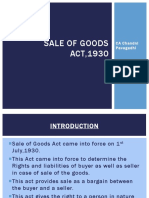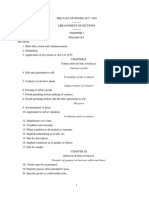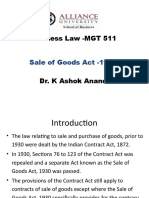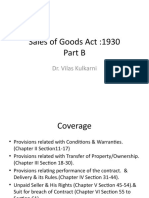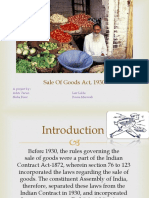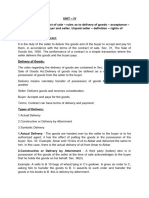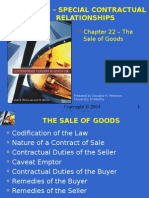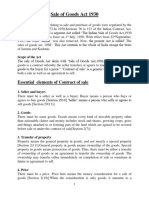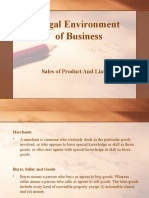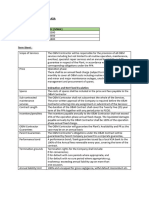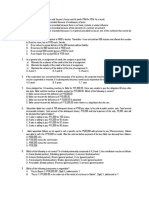1.
Formation of the Contract of Sale
Section 2(1) Definition
A contract of sale is where the seller transfers or agrees to transfer the property in goods
to the buyer for a money consideration (called the price).
"Property in Goods":
Refers to legal ownership of tangible (physical) items.
The buyer gains the right to possess, use, and dispose of the goods.
It is different from intellectual property.
Definition of "Goods" [Section 2]
Includes all movables, except money . Growing crops,Items attached to land but agreed to
be removed before or under the sale. Immovables like land/buildings (these are transferred
only by deeds) are excluded.
Why Money is Excluded
Money is a medium of exchange, not a commodity. It cannot be used as an input for
production like goods can. Re Hirdaramani
Dealt with foreign currency and black market dealings.
Held- Money is not goods under the Ordinance; transaction was not covered.
Malwatte Valley Plantations v. Commission of Inland Revenue- Sale of rubber trees was
held to be a sale of goods because the obligation to uproot was secondary to the sale of the
goods
2. Ownership and Types of Contracts
Reckitt Benckiser v. Commissioner of Inland Revenue- Ownership means transfer of title
(property).
Unilever Sri Lanka v. CGIR- Differentiated between contracts for service (where skill/labour
is dominant) and contracts for sale of goods (where goods are dominant).
Types of Contracts [Sections 2(2)-(4)]
1. Absolute Sale- mmediate transfer of ownership.
2. Conditional Sale- Ownership passes only when a future event or condition is fulfilled.
Jayasena Perera v. Ratnadasa- There was only an agreement to sell, not an actual sale, as
ownership would transfer later.
Perera v. Benedict- Sale of liquor without a license was not legally valid as a sale.
1
�3. Capacity to Contract
General Rule
Capacity to buy/sell is governed by general law (contract and property law).
Minors, mentally incapacitated persons, drunk persons: Limited capacity.
If necessaries are sold to such persons, they must pay a reasonable price.
"Necessaries"
Goods suitable to the person's condition in life and needs. Nicholas v. Thomas Appu
Money lent to a minor who fled.
Held: A minor cannot be contractually liable, but may be liable in delict (civil wrong).
4. How a Contract May Be Made [Section 4]
Written
Oral
Partly written, partly oral
Implied by conduct
5. Enforceability of Contract [Section 5]
A sale is unenforceable unless
1. Buyer accepts and receives the goods.
2. Payment of part of the price or giving something in earnest.
3. Written memorandum signed by the party to be charged.
6. Types of Goods [Section 6]
Existing Goods- Already owned by seller.
Future Goods- To be manufactured/acquired after contract.
Contingent Goods- Depends on uncertain event.
Sale of future goods is an agreement to sell.
7. Perished Goods [Sections 7-8]
Section 7- Goods perish before contract—contract is void.
Section 8- Goods perish after agreement but before risk passes—contract is avoided.
Othman v. Jinadasa- Goods lost in transit—ownership (and risk) still with seller, so buyer not
liable.
2
�8. Price of Goods [Sections 9-10]
Section 9- Ascertainment of Price
May be,
o Fixed by contract.
o Determined by previous dealings.
o Determined by reasonable price (if no prior agreement).
Section 10- Price by Third Party Valuation
If third party fails to value,
o Agreement is void unless goods delivered.
o If failure is due to one party's fault → damages can be claimed.
Conditions and Warranties
Warranty- A less important term. If broken, the buyer can claim money (damages) but cannot
cancel the sale or return goods.
Condition- A key term. If broken, the buyer can cancel the sale and return goods.
KIA Motors v. CAA – Shows the difference between condition and warranty.
Section 11 – Time of Payment
Paying on time is not essential unless the contract says so.
"Month" means calendar month unless agreed otherwise.
Section 12 – Waiving Conditions and Warranties
12(1): Buyer can choose to treat a broken condition as a warranty.
12(2): Labels (words) in the contract do not decide if something is a condition or warranty—
meaning matters.
12(3): If goods are accepted, some broken conditions can only be treated as warranty.
12(4): Some conditions don’t need to be followed if impossible by law.
Section 13 – Implied Terms
Seller must,
o Have the right to sell.
o Give the buyer peaceful possession.
o Make sure goods are free from hidden legal claims.
3
�Section 14 – Sale by Description
Goods must match their description.
If sold by both sample and description, must match both.
Section 15 – Quality and Fitness
If buyer relies on seller's advice, goods must suit the purpose.
Goods must be good quality (merchantable).
No promises if,
o Goods are sold under a trade name.
o Buyer inspects and finds defects.
Trade customs and other warranties may apply.
Section 16 – Sale by Sample
Bulk must match the sample.
Buyer can check sample.
Goods must have no hidden defects.
Section 17 – Unascertained Goods
goods are not identified, ownership does not pass to the buyer.
Section 18 – Specific Goods
For specific goods, ownership passes when the parties intend.
Section 19 – Rules on When Ownership Passes
Rule 1
Ready goods: Ownership passes when the contract is made.
Rule 2
If something must be done to the goods first, ownership passes after it's done and buyer is
informed.
Rule 3
If goods must be weighed or measured, ownership passes after this and after the buyer is
informed.
Rule 4
Sale on approval- Ownership passes when buyer accepts or keeps goods too long without
returning.
4
�Rule 5
For unascertained/future goods
o Ownership passes when goods are set aside (appropriated) for the buyer with agreement.
o If delivered to a carrier without seller keeping control, ownership passes.
What is "Performance of the Contract"?
It means the seller and buyer must do what the contract says,
o Seller must deliver the goods.
o Buyer must accept and pay for the goods.
If the contract is silent, the Sale of Goods Ordinance (SOGO) applies.
Section 27 Basic Duties
Seller- Deliver the goods.
Buyer- Accept the goods and pay the price.
Section 28 Payment and Delivery Happen Together
Buyer must pay when goods are delivered unless the contract says otherwise.
Section 29 Rules on Delivery
1. Delivery doesn’t always mean handing over physically, it’s about giving control to the buyer.
2. If time isn’t fixed, goods must be delivered in reasonable time.
3. If goods are with a third party (like a warehouse), there’s no delivery until that person
agrees they hold it for the buyer.
4. Delivery must be at a reasonable hour.
5. Cost of delivery is the seller’s responsibility unless agreed otherwise.
Section 30 Wrong Quantity
1. Short delivery
Buyer can reject or accept and pay for the goods received.
2. Excess delivery
Buyer can reject all, reject the extra, or accept all and pay.
3. Mixed goods
Buyer can reject all or accept correct items and reject the rest.
5
�Hammond v Anderson; Mitchell Reid & Co v Buldeo Dass
Section 31 Instalment Delivery
Buyer doesn’t have to accept goods in parts unless agreed.
If one instalment is faulty, the buyer may reject the full contract. Reuter v Sala
Section 32 Delivery to Carrier
Giving goods to a delivery company = delivery to buyer.
Seller must choose a proper carrier unless buyer chooses.
Section 34 Right to Examine Goods
Buyer can inspect goods before accepting.
Perkins v Bell; Assen Cutty v Brooke Bond
Section 35 Acceptance
Buyer accepts goods if,
o They say so.
o They use/resell goods.
o They keep goods too long without rejecting. Hardy v Hillerns
Section 36 No Duty to Return Rejected Goods
Buyer doesn’t have to return rejected goods—just inform the seller.
Section 37 Buyer's Refusal to Take Delivery
Buyer must pay for losses if they refuse without reason. Charter v Sullivan
Rights of Unpaid Seller (Sections 38–45)
Who is an Unpaid Seller?
Not fully paid or payment failed (like bounced cheque).
Seller’s Rights
1. Lien: Keep goods until paid.
2. Stoppage in Transit: Stop delivery if buyer becomes insolvent.
3. Re-sale: Sell to someone else if buyer defaults.
4. Withhold delivery if property hasn’t passed to buyer.
Lien (Sec 40-42)
Keep goods when,
6
� o No credit given.
o Credit expired.
o Buyer insolvent.
Lien lost if,
o Goods given to a carrier without control.
o Buyer or agent gets the goods.
Stoppage in Transit (Sec 43-45)
Stop goods while they are being delivered if buyer is insolvent.
Delivery ends transit.
Seller must give notice to stop transit.
Re-sale
Seller can resell goods:
o If goods are perishable.
o If buyer doesn't pay after notice.
Banking Law
What is a Bank?
No single definition. Different laws define it differently
o Evidence Ordinance- Any banking business.
o Bills of Exchange Ordinance- Any business of banking.
o Companies Ordinance- Principal business is accepting deposits.
o Income Tax Ordinance- Body doing banking business.
Types of Banks
1. Commercial Banks- Take deposits and offer loans.
2. Specialized Banks- Focus on industries, agriculture, housing (e.g., NSB, DFCC).
Key Laws in Banking
Monetary Law Act
Banking Act 1988
7
� Debt Recovery Acts
Financial Transactions Reporting Act
Computer Crime Act
1. Conveyancing in Sri Lanka
8
�What is Conveyancing?
Conveyancing refers to the legal process of transferring ownership of property (either land
or buildings) from one party to another through valid legal documents (deeds).
It ensures that,
1. The seller has the legal right to transfer the property.
2. The buyer becomes the lawful owner.
3. The transaction is properly recorded in the land registry.
Key Legal Framework for Conveyancing
Law Purpose
Prevention of Frauds Ordinance No.7 Requires that certain contracts, especially involving
of 1840 land, be in writing and attested.
Registration of Documents Ensures that all deeds affecting land are registered to
Ordinance No.23 of 1927 provide notice to the public.
Governs the role and duties of notaries who draft,
Notaries Ordinance No.1 of 1907
attest, and register deeds.
Stamp Duty Act No. 43 of 1982 Imposes stamp duty (tax) on the execution of deeds.
Who Handles Conveyancing?
Only a Licensed Notary Public (NP) can,
o Draft the deed
o Verify the identities of parties
o Ensure legal compliance
o Register the deed in the Land Registry.
Common Types of Deeds
Deed Type Purpose
Deed of Transfer Sale and transfer of ownership for value.
Deed of Gift Voluntary transfer without consideration.
Executor's Conveyance Transfer of property by the executor of a will.
9
�Deed Type Purpose
Administrator's Transfer by a court-appointed administrator in the absence of a
Conveyance will.
Deed of Partition Division of jointly owned property.
Power of Attorney Appointing someone to act legally on your behalf.
Importance
Ensures legal certainty for property owners.
Prevents fraud and disputes.
Makes property marketable for future transactions.
Examination of Title (Ensuring Good Title Before Sale)
What is Examination of Title?
It is the process of verifying the legal ownership of a property before executing a transfer
deed.
The Notary checks to ensure that,
o The seller actually owns the property.
o There are no hidden claims, mortgages, or legal problems affecting the land.
Key Steps in Title Examination
Step Explanation
Use survey plans, lot numbers, and boundaries to identify the
1. Land Identification
property.
Examine Land Registry records for prior deeds, court orders,
2. Search Registers
mortgages, or caveats.
Ensure ownership can be traced unbroken for at least 30 years or
3. Check Title Chain
from a reliable starting point (e.g., Crown Grant).
4. Check Confirm no outstanding loans, leases, taxes, or court cases
Encumbrances affecting the property.
All previous sellers must have been legally capable (not minors,
5. Capacity of Parties
insolvents).
6. Local Authority Confirm street line certificates, non-vesting certificates, and planning
10
�Step Explanation
Approvals approvals.
7. Prepare Abstract of A summary of ownership history, key documents, and events affecting
Title title.
Important Concepts
Concept Meaning
Root of Title The original starting point of ownership.
Chain of Title The sequence of ownership from past to present.
Encumbrance A burden on the property (e.g., mortgage, court seizure).
Abstract of Title A written summary of the history of ownership and key legal events.
Key Documents in Examination
Deeds (past transfers, gifts, wills)
Court decrees (partition, mortgage cases)
Survey plans
Death, marriage, and birth certificates
Local authority certificates
3. Intestate Succession (Inheritance Without a Will)
What is Intestate Succession?
When someone dies without leaving a valid Will, their property is distributed according to the
Matrimonial Rights and Inheritance Ordinance No.15 of 1876 (general law).
Key Rules of Succession
11
�Situation Who Inherits? Section
Surviving Spouse + Section 22-
Spouse gets ½, children share ½ equally (per capita).
Children 24
Parents inherit equally; if one parent, balance goes to
No Children → Parents Section 25
siblings.
No Parents → Full and half-siblings inherit equally; their children take Section 26-
Brothers/Sisters by representation (per stirpes). 29
No Siblings →
Grandparents inherit per capita. Section 31
Grandparents
No Grandparents →
Uncles, aunts, and their children inherit. Section 31
Uncles/Aunts
No Heirs → Spouse alone If no heirs, spouse inherits all; if no spouse, the Section 32,
or State property escheats to the Crown (State). 34
Term Meaning
Per Capita All heirs of the same class share equally.
Per Stirpes Descendants take the share their parent would have taken.
Escheat If no heirs exist, the property passes to the State.
Illegitimate children can inherit only from the mother’s intestate estate (Section 33).
Movable and immovable property are treated differently based on domicile and location
4. Transfer of Title & Exceptions to Nemo Dat Rule
What is Nemo Dat?
Latin: “No one can give what they do not have.” A person cannot pass better ownership than
they hold.
Why Are There Exceptions?
To protect innocent third parties (buyers) and to maintain commercial confidence in
markets.
Exception Meaning Conditions
Estoppel (Section If the true owner’s behavior leads the Owner’s conduct must
22(1)) buyer to believe the seller has authority. mislead; buyer must act in
12
�Exception Meaning Conditions
good faith.
Agents can transfer good title if in
Sale by Mercantile Buyer must act in good
possession with consent and acting in
Agent (Section 22(2)(a)) faith.
the ordinary course of business.
Sale by Court Order or
A sale under law or court order passes Lawful process must be
Statute (Section 22(2)
valid title. followed.
(b))
If the seller has a title that can be voided,
Voidable Title (Section Buyer must be unaware of
but hasn’t yet, buyer in good faith gets
23) defects.
valid title.
Stolen Goods (Section Buyer usually gets no title, but fraud may Depends on case facts
24) allow title to pass. (e.g., conviction for theft).
If seller, after selling, remains in
Seller in Possession Buyer must act in good
possession and resells, innocent buyer
(Section 25(1)) faith.
can get title.
Buyer who resells before title completes
Buyer in Possession Must be in possession with
can pass valid title to an innocent sub-
(Section 25(2)) seller’s consent.
buyer.
Unpaid Seller's Right to Unpaid seller can resell if the original Buyer must be unaware of
Resell (Section 47(2)) buyer defaults. the first sale.
Sale by Execution of Sale by sheriff, fiscal, or under court Sale must comply with legal
Court (Section 26) execution passes clean title. procedure.
13









